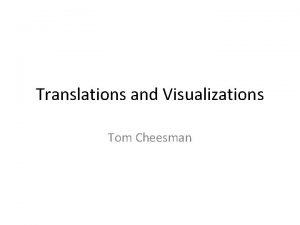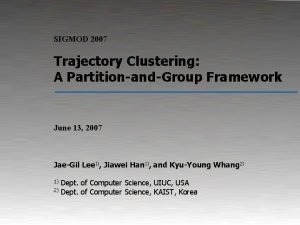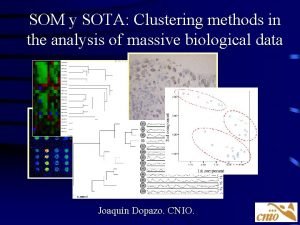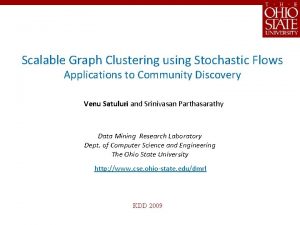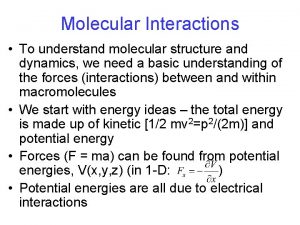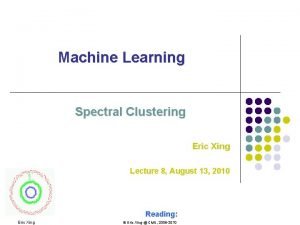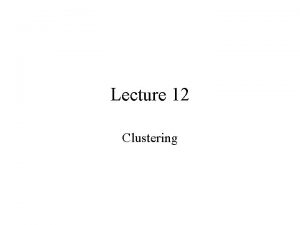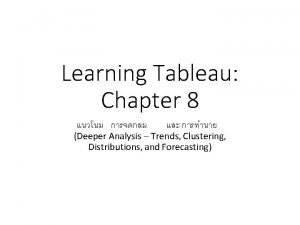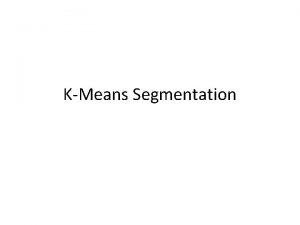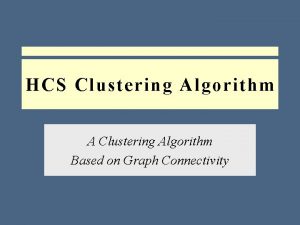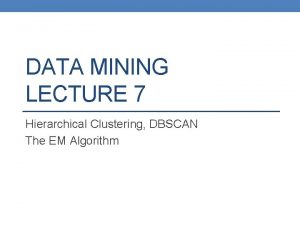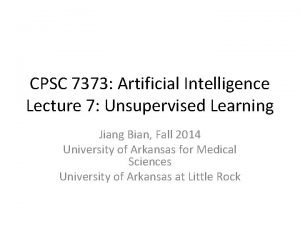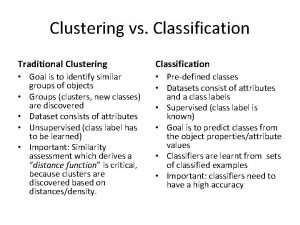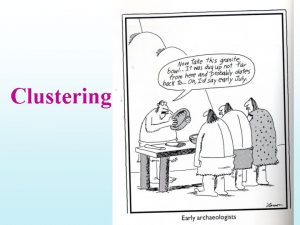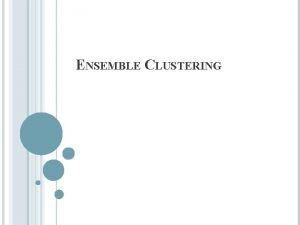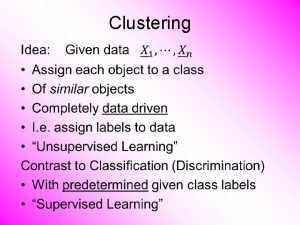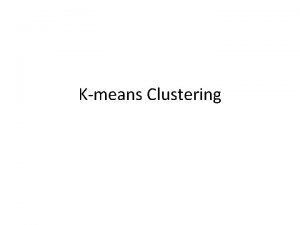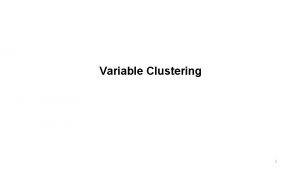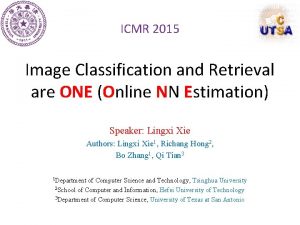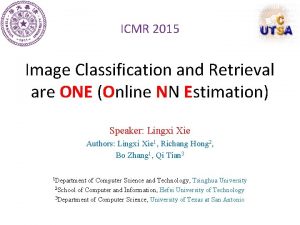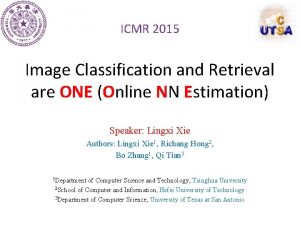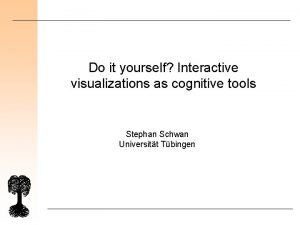ICMR 11 Adaptive Clustering and Interactive Visualizations to

























- Slides: 25

ICMR ‘ 11 Adaptive Clustering and Interactive Visualizations to Support the Selection of Video Clips 1

Outline • • • Introduction Related Work Keyframe Browsing Segmentation Selection Keyframe Selection Clustering of Keyframes • Backtrack-balanced Clustering Algorithm • Split-balanced Clustering Algorithm • Evaluation Results 2

INTRODUCTION • Although people are capturing more video with their mobile phones, digital cameras, and other devices, they rarely watch all that video. • More commonly, users extract a still image from the video to print or a short clip to share with others. • They created a novel interface for browsing through a video keyframe hierarchy to find frames or clips. 3

INTRODUCTION • They designed a keyframe-based interface for browsing video on devices with a variety of screen sizes. • The interface provides different parts of the video by presenting a keyframe hierarchy along a timeline that allows users to quickly zoom in on an area of interest in the video. 4

INTRODUCTION • If the user specifies that he is looking for a single image in the video, the interface is based on a non-temporal visual clustering algorithm that groups keyframes by similarity. • If the user is looking for a video clip, the system first analyzes the video to determine whether it is visually repetitive or non-repetitive. Then the system chooses among two temporal-visual clustering algorithms that group the keyframes based on visual similarity while ensuring that the temporal order of the keyframes is preserved and that navigation paths are kept short. 5

RELATED WORK • Systems offering keyframe-based interfaces for video access are widespread. • algorithms for segmenting a video into smaller, meaningful pieces • algorithms for identifying important keyframes from videos and video segments • visualizations for summarizing video through storyboarding, compositing keyframes, and selective playback • While there are other systems supporting user-generated or home video, the majority of video browsing interfaces are geared towards professionally produced video. 6

KEYFRAME BROWSING • They created a user interface that presents a video via hierarchically-organized keyframes. • Users can use the keyframes to navigate to an interesting part of the video and then use neighboring keyframes and a timeline to explore that part of the video. 7

KEYFRAME BROWSING • The cluster tree is not shown to the user because its tiny keyframes make it unsuitable for exploration in a constrained display size. 8

KEYFRAME BROWSING • The visualization shown in figure consists of a series of keyframes selected as cluster representatives. • They are placed above a timeline of the video showing the position and length of the corresponding video segments in the context of the overall video. 9

KEYFRAME BROWSING 10

Segmentation Selection • For finding video segment boundaries, they use a 10 -second wide Gaussian checkerboard kernel that we move across the selfsimilarity matrix of frames in the video sampled at 5 fps. • The self-similarity matrix is composed of the color similarities between frames. • The amount of correlation with the kernel provides the strength of a segment boundary. • They select the strongest boundary between every pair of adjacent keyframes as the distance for the temporal clustering algorithms. 11

Keyframe Selection • When selecting keyframes, their algorithm check all frames in the video and picks the least blurry frames at an average rate of 2 fps. • They adapted an approach for determining the blurriness of a photo using the strength of the top 10% edges and the entropy of the edge histogram. • This techniques avoids blurry frames and skip keyframes that are too dark. 12

Clustering of Keyframes • For clustering keyframes, they started with looking at three extremes. • First, they used complete-link hierarchical agglomerative clustering solely based on visual similarity without temporal order 13

Clustering of Keyframes • Second, they clustered by visual similarity while only merging temporally adjacent clusters. • Unfortunately, the requirement of keeping keyframes in temporal order while maintaining visual similarity can cause very unbalanced cluster trees. 14

Clustering of Keyframes • Third, they created a complete tree in temporal order without any clustering. • By definition, this produces the most balanced tree but the sub-trees do not represent any groupings beyond temporal adjacency. 15

Clustering of Keyframes • They present two new clustering algorithms: • backtrack-balanced • split-balanced • They generate temporally contiguous clusters while also producing fairly balanced trees with average navigation path lengths slightly longer than in balanced trees. • Both algorithms relax the constraint that the most visually similar keyframes in a time interval should be in the same cluster. 16

Backtrack-balanced Clustering Algorithm(1/3) • Rather than considering all pairs of clusters when deciding which cluster to merge next, only pairs of clusters that are temporally adjacent are considered. • Their algorithm uses a bottom-up clustering approach while limiting the number of cluster elements. • The algorithm takes as inputs the tree branching factor b, the list of keyframes in the video in temporal order, and a distance function to determine cluster distances. 17

Backtrack-balanced Clustering Algorithm(2/3) • 18

Backtrack-balanced Clustering Algorithm(3/3) • If sub-clustering a cluster produces more than b subclusters, because no more sub-clusters can be merged, the algorithm marks the cluster as undesirable and backtracks to the point where the undesirable cluster was created. • If backtracking happens at the root of the tree, the algorithm starts over with an increased overall tree height. 19

20 reduce the maximum depth

Split-balanced Clustering Algorithm(1/2) • The split-balanced algorithm performs top-down clustering by recursively splitting clusters until sub-clusters do not contain more keyframes than the branching factor. • The algorithm include two constraints. • First, each sub-cluster is kept between 1/3 and 3 times the average duration to make sure that all clusters have a good representation in the timeline. • Second, sub-clusters are not assigned more keyframes than the remaining tree height. To avoid over constraining, each level of the tree is given an additional padding of 8%. 21

Split-balanced Clustering Algorithm(2/2) • To determine the best split for a video sequence, the same number of keyframes are initially assigned to each sub-cluster. • The algorithm keeps picking the boundary with the least strength and replaces it with the strongest possible boundary between the neighboring boundaries that satisfies the constraints of cluster and number of cluster members. • Once no better boundaries can be found, the sub-clusters are clustered recursively. 22

23

Evaluation Results • For the 14 videos, they extracted keyframes at 3 fps. • To avoid different durations, they truncated longer videos to 3 minutes. They evenly subsampled those keyframes to between 48 and 256 frames. • They applied all clustering algorithms to each set of frames with a tree branching factor of 4. • The temporal-visual algorithm generated trees up to a height of 15 and the visual algorithm up to a height of 8. 24

Evaluation Results Average navigation distances to a matching frame (dark gray) and its temporal neighbor (light gray). 25
 Flat cluster
Flat cluster Divisive hierarchical clustering example
Divisive hierarchical clustering example Euclidean distance rumus
Euclidean distance rumus Five food groups by icmr
Five food groups by icmr Icmr art clinic registration form
Icmr art clinic registration form Delighted visualizations
Delighted visualizations Trajectory clustering: a partition-and-group framework
Trajectory clustering: a partition-and-group framework Classification and clustering in data mining
Classification and clustering in data mining Classification and clustering
Classification and clustering Clustering vs classification
Clustering vs classification Sota clustering
Sota clustering Graclus
Graclus Hydrophobic clustering
Hydrophobic clustering Eric xing
Eric xing Brown clustering
Brown clustering What is clustering
What is clustering Tableau clustering algorithm
Tableau clustering algorithm Spectral clustering
Spectral clustering Hcs clustering algorithm
Hcs clustering algorithm R&cm
R&cm Dbscan hierarchical clustering
Dbscan hierarchical clustering Cure: an efficient clustering algorithm for large databases
Cure: an efficient clustering algorithm for large databases Bi clustering
Bi clustering Spectral clustering
Spectral clustering Clustering vs classification
Clustering vs classification Clustering ideas
Clustering ideas





